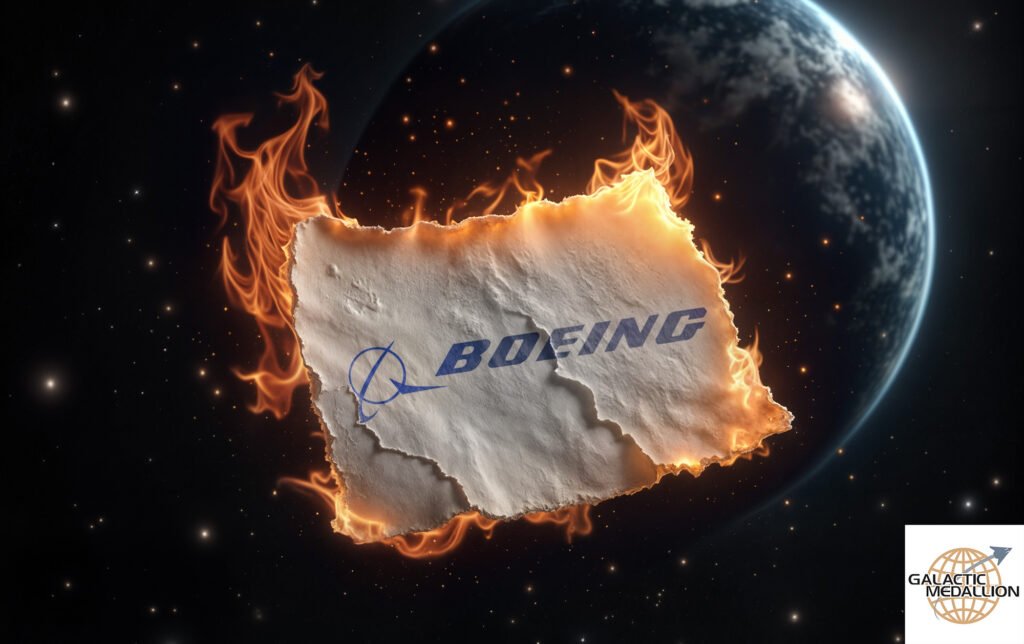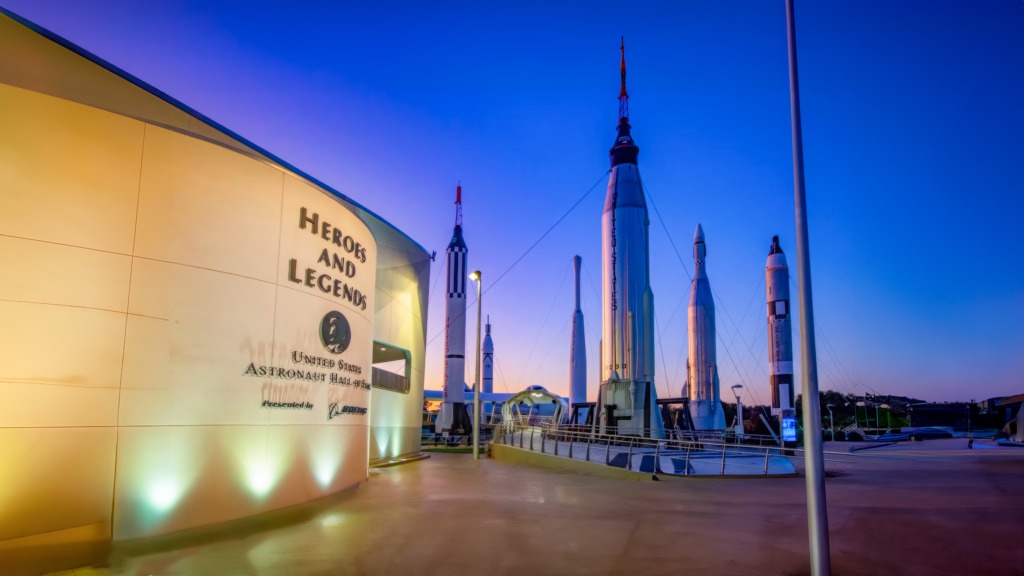Boeing’s empty Starliner capsule drifted down to the New Mexico desert in the quiet of night, its parachutes billowing beneath a moonlit sky. Conspicuously absent were the two astronauts who were supposed to be inside. NASA had left test pilots Barry “Butch” Wilmore and Sunita Williams aboard the International Space Station instead after thruster malfunctions and a stuck valve leak marred Starliner’s journey and made the capsule’s return too risky. What should have been a triumphant milestone—Boeing’s first crewed mission of a new spacecraft—had turned into yet another public embarrassment for the storied aerospace company. And this scene was not an isolated incident; it was the latest entry in a troubling chronicle of Boeing setbacks, one that spans from the Earth’s orbit to the runways of its commercial jets.
Over the past decade, Boeing’s reputation for engineering excellence has been repeatedly punctured by high-profile failures. The same company that once symbolized aeronautical perfection is now more often associated with crisis. Its 737 MAX airliner was grounded worldwide after two horrific crashes killed 346 people. Its flagship 787 Dreamliner endured years of delays and technical glitches, including battery fires that grounded the fleet in 2013. Even Boeing’s commercial satellite business has not been immune, with a state-of-the-art Intelsat spacecraft suffering a total failure in orbit far earlier than expected. Many aviation insiders and former engineers argue that these calamities stem from a common root cause: a profound shift in Boeing’s corporate culture and priorities following its 1997 merger with McDonnell Douglas. What was once “an association of engineers devoted to building amazing flying machines” began to morph into something quite different.
A Culture Rewired After 1997
Late in the summer of 1997, Boeing merged with its long-time rival McDonnell Douglas, creating a single aerospace behemoth. On paper, Boeing absorbed McDonnell Douglas; in practice, as many observers have noted, McDonnell Douglas’s profit-driven ethos absorbed Boeing. It was a classic clash of cultures: Boeing’s tradition of engineer-led innovation versus McDonnell Douglas’s Wall Street-pleasing frugality. “The fatal fault line was the McDonnell Douglas takeover,” says aviation author Clive Irving. “Although Boeing was supposed to take over McDonnell Douglas, it ended up the other way around”. In the years that followed, Boeing’s leadership increasingly emphasized cost-cutting, stock performance, and production speed at the expense of the meticulous engineering and testing that had once been the company’s hallmark. Management distanced itself from its engineering roots—moving headquarters from Seattle to Chicago in 2001—and senior executives with non-technical backgrounds came to the fore. It wasn’t long before this new “bean-counter” philosophy began to reshape how Boeing designed and built its aircraft.
Internally, veteran Boeing engineers began to feel marginalized. Since the dawn of the jet age, Boeing’s identity had been forged by engineering prowess and safety-first principles. Employees often cited the old company credo of “go-for-it-and-damn-the expenses—but not damn the quality”as the unwritten rule. But after the merger, that credo faded. In its place came relentless pressure to streamline and outsource. Boeing’s new top brass—many imported from outside the aerospace world—sought to “digitize” and “partner” their way to higher margins. The result was a fundamental shift: decisions that would have once been guided by seasoned engineers and exhaustive testing were now increasingly driven by financial metrics and program schedules. This transformation would soon manifest in Boeing’s next generation of projects—with mixed, even disastrous, results.
The Dreamliner: Ambition Meets Turbulence
The first major test of Boeing’s post-merger philosophy was the 787 Dreamliner program. Billed as a revolutionary leap in airliner design, the 787 was indeed bold in concept: it introduced lightweight composite materials and promised unprecedented fuel efficiency. But it was Boeing’s new approach to building the plane that truly marked a departure from the past. The company radically increased outsourcing, dispersing design and manufacturing to a global web of suppliers in an effort to save money and time. It didn’t go as planned. By 2011, unfinished Dreamliners were accumulating outside Boeing’s factories, sitting engineless and incomplete as delays mounted. The program ended up running nearly three years behind schedule and several billion dollars over budget. Insiders at the time lamented what one union official called the “seismic shift in plane-making strategy” that the Dreamliner represented. Instead of Boeing’s traditionally tight control over design and production, critical work had been farmed out to partners who struggled to meet Boeing’s standards and timelines.
When the Dreamliner finally entered commercial service, Boeing’s troubles did not end. In January 2013, a Japan Airlines 787 parked at Boston’s Logan Airport suffered a smoldering fire—its advanced lithium-ion battery had gone into thermal runaway. A second battery incident on an All Nippon Airways 787 occurred days later. The FAA promptly grounded the entire global Dreamliner fleet. Investigators discovered design and manufacturing flaws in the battery system that had somehow slipped through certification. According to the U.S. National Transportation Safety Board, the battery’s design was flawed and “should not have been certified” by the FAA. Boeing had to hurriedly redesign the battery enclosure and add safeguards before the 787s could fly again. Though no one was injured in those incidents, the message was clear: the once-impeccable Boeing engineering apparatus had allowed a serious hazard to reach airline service. The Dreamliner’s painful birth and early stumbles offered an early warning that Boeing’s new way of doing business—aggressive outsourcing, compressed timelines, and perhaps compromised oversight—was a double-edged sword.

The 737 MAX: Costly Cut Corners
If the Dreamliner exposed cracks in Boeing’s new paradigm, the 737 MAX would shatter the company’s complacency. By the mid-2010s, Boeing faced intense pressure from Europe’s Airbus, which was selling its efficient A320neo jets like hotcakes. Rather than design an all-new single-aisle airplane to compete, Boeing’s leaders doubled down on a strategy of derivative design—upgrading the venerable 737 yet again. The result was the 737 MAX, featuring bigger, more fuel-efficient engines mounted in a way that subtly altered the plane’s aerodynamics. Instead of going back to the drawing board to thoroughly re-engineer the airframe, Boeing tried to code its way out of the problem. It added software —the now-infamous Maneuvering Characteristics Augmentation System (MCAS)—to automatically push the nose down in certain situations and compensate for the jet’s new flying characteristics. In essence, it was a software bandaid on a hardware problem, one that allowed Boeing to claim the MAX flew “just like” the old 737 to avoid costly pilot retraining for airlines.
That gamble with MCAS proved calamitous. In October 2018, Lion Air Flight 610— a nearly brand-new 737 MAX — plunged into the Java Sea. Less than five months later, in March 2019, Ethiopian Airlines Flight 302 met a similarly horrifying fate shortly after takeoff from Addis Ababa. All passengers and crew aboard both flights perished. The culprit in both crashes was traced in large part to MCAS, which, fed by a single faulty sensor, repeatedly forced the planes into uncontrollable dives. Regulators around the globe swiftly grounded every 737 MAX in service. Boeing’s most important product line was now paralyzed as the company raced to fix the software and regain trust. The human toll—346 lives lost—was tragic, and the financial fallout was staggering, with costs to Boeing soaring into the billions. Perhaps most devastating of all was the blow to Boeing’s credibility. Investigations uncovered a paper trail of internal warnings ignored and a certification process that had allowed MCAS’s dangers to go overlooked. The 737 MAX crisis became the embodiment of Boeing’s post-merger malaise: a case study in how commercial and competitive pressures overrode engineering common sense, with deadly consequences.
Starliner: A Capsule and a Company Adrift
Boeing’s struggle to uphold its legacy hasn’t been confined to commercial airplanes. The company’s foray into human spaceflight with its CST-100 Starliner spacecraft has been another harsh lesson in the costs of diminished rigor. As one of two vehicles in NASA’s Commercial Crew program (SpaceX’s Crew Dragon being the other), Starliner was meant to showcase Boeing at its best—building on decades of heritage dating back to Apollo-era capsules. Instead, it has spotlighted Boeing at its most erratic.
The troubles began with Starliner’s very first orbital test flight in December 2019. Despite launching atop an Atlas V rocket successfully, the capsule suffered a timing software glitch shortly after reaching space. The autonomous flight computer believed the spacecraft was in a different phase of mission, causing Starliner to burn through fuel at the wrong time. By the time engineers corrected the error, the window to rendezvous with the International Space Station (ISS) had closed. Boeing had to bring the spacecraft home after just two days, having accomplished only a fraction of the intended objectives. In the course of investigating that failure, NASA and Boeing uncovered a second software defect that could have caused a catastrophic thruster misfire in orbit — a bullet dodged only by chance and last-minute ground intervention. An exhaustive joint review identified dozens of corrective actions for Boeing’s team — 80 fixes, all told, addressing everything from coding processes to testing rigor. Boeing’s space unit, much like its commercial airplane side, had to confront the reality that lapses in quality and oversight had crept in. It would take more than two years and a repeat uncrewed test flight (finally successful in mid-2022) before NASA cleared Boeing to put astronauts on Starliner.
That moment of redemption was supposed to come in 2023 and then 2024. It came — and went — under grim circumstances. When Boeing finally did launch a crew on Starliner in June 2024, it carried NASA astronauts Wilmore and Williams aloft for a rendezvous with the ISS. But scarcely had Starliner reached orbit when new problems arose. This time, a cluster of thrusters misbehaved and a persistent helium leak impaired the spacecraft’s propulsion system. Starliner did make it to the space station, delivering its two-person crew, yet the celebrations were muted. Engineers on the ground fretted over the capsule’s condition. After weeks of analysis, NASA made a fateful call: Wilmore and Williams would not ride Starliner home. The risks of its thruster anomalies were deemed unacceptable. Instead, the astronauts stayed aboard ISS to await a return trip via other means, and Starliner was sent back to Earth empty. The optics were striking—Boeing’s spacecraft undocking from the ISS with no one on board, essentially conceding failure. When that empty capsule touched down under its parachutes at White Sands in September 2024, it was a somber bookend to a mission that should have been a shining triumph. Boeing’s hard-won second chance had instead underscored persistent weaknesses in its engineering and quality culture. As of early 2025, Starliner’s future is uncertain, with Boeing and NASA regrouping yet again to determine how to fix the capsule once and for all before attempting another crewed mission.
Weakened Pillars and a Way Forward
Even outside of airplanes and crewed spacecraft, technical setbacks have haunted Boeing in recent years. In October 2024, a Boeing-built satellite called Intelsat-33e abruptly failed in geostationary orbit, breaking into dozens of pieces and shocking an industry where satellites typically operate reliably for decades. The communications satellite was just seven years old—roughly half its expected lifespan—when an unexplained anomaly knocked it out of service. Its operator declared it a “total loss” and had to scramble to redistribute customers to other satellites. Intelsat and Boeing are still investigating what went wrong, but the mere fact of such a failure is jarring. It hints that the erosion of Boeing’s vaunted rigor may not be confined to headline-grabbing airplanes, but could be systemic, spanning everything from commercial jets to space systems.
For Boeing, the costs of this era of missteps have been steep: lost lives, billions in financial penalties and settlements, canceled orders, delayed programs, and a tarnished brand that took generations to build. The deeper loss, however, is an intangible one—trust. Airlines, astronauts, regulators, and the flying public have all, in various ways, lost some degree of confidence in Boeing. Rebuilding that trust will require more than fixes to software code or tweaks to assembly lines; it will require a recommitment to the principles that once made Boeing an icon of safety and innovation. That means empowering engineers to speak up and prioritize safety without fear of schedule or budget overruling them. It means management is willing to say no to a program or customer if the design isn’t truly ready. In the wake of the 737 MAX crashes, Boeing’s board ousted its CEO, and the company has pledged to reinforce safety oversight. There are cautious signs of introspection—fortifying engineering review boards, realigning the organizational structure, and even relocating the headquarters again (this time from Chicago to Arlington, closer to Washington regulators and the heart of the aerospace industry). Yet cultural course corrections in a giant corporation are slow, difficult moves. Boeing’s challenges didn’t form overnight, and they won’t be fixed with a simple corporate memo or reorg chart.
In the 20th century, Boeing thrived by pairing visionary engineering with prudent management—a balance that yielded epochal machines like the 747 jumbo jet and the Saturn V rocket. The 21st century has so far told a more cautionary tale. Boeing became a case study in how a superlative engineering enterprise can falter when financial priorities and complacency eclipse the critical eye of its engineering conscience. The hopeful view is that Boeing’s recent low points—the Max disasters, the Starliner saga, the Dreamliner woes—might catalyze a renaissance of the old Boeing spirit. As the company works to get the Starliner flying with crews safely, to deliver a trouble-free 777X airliner, and to ensure no more satellites drop out of the sky, one suspects the path to redemption lies in rediscovering what once made Boeing great. It may well mean rekindling that bygone philosophy that guided the company during its golden years: build it right, “damn the expenses—but not damn the quality”.




